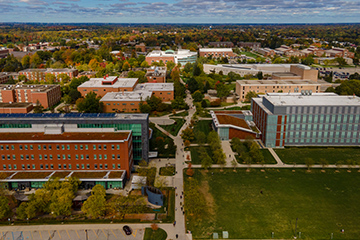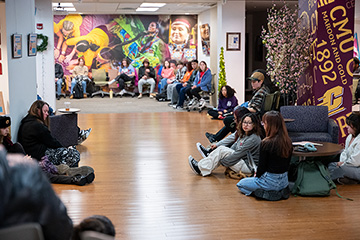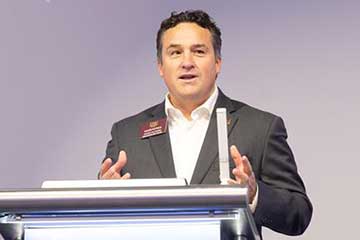A "roadmap" for change at CMU
President MacKinnon and Darcie Wilson discuss change management
In this story: CMU President Neil MacKinnon and Chief Transformation Officer Darcie Wilson discuss:
- The definition, tools and processes that drive change management.
- How CMU will engage members of the university community in understanding the “which, why, how, when and what” of coming changes.
- Next steps for the development of a change management “roadmap.”
For years, Central Michigan University has been navigating the changing — and often challenging — landscape of higher education, including shifting perceptions about the value of a college degree, population and demographic changes, and declining enrollment. Now, with several action plans and priorities in place, the university community must prepare to implement new strategies.
University Communications sat down with CMU President Neil MacKinnon and Chief Transformation Officer Darcie Wilson to talk about what this means for students, faculty and staff.
UCOM: Change happens every day – most of us experience and must adapt to it regularly. So, why do we need to talk about managing change?
Wilson: It’s true that change happens every day, but not all changes affect how people work together or will deeply impact their day-to-day processes or practices. When change is significant enough to disrupt people’s routines, or if the change requires people to adopt a new way of working or introduces uncertainty, it requires change management strategies.
For example, consider the difference between moving a chair in your office — an everyday change — and renovating the entire office. The first you can do and adjust to on your own, the second requires communication and cooperation so everyone can function well in the new space.
MacKinnon: There are times when we choose to change and times when change is thrust upon us. Unfortunately, in some ways, the latter is true for us now. CMU has had a long period of enrollment declines and several prior years of budget reductions, sometimes due to factors beyond our control. We want to change that trajectory and grow as a university.
For example, CMU’s enrollments dropped from over 25,000 to just over 14,000 over the past decade. The status quo was not acceptable. We have had great, dedicated people doing good work in admissions and enrollment and across the university, but we needed to try some new things. We’re developing a strategic enrollment management plan that we hope will have some novel ideas and get people excited. Implementing that plan will require us to do things differently. It won’t just be one office; it will be every office – it will be everyone. There will be significant changes for all of us.
UCOM: The strategic enrollment management plan is just one of the things we’re working on right now. There’s also the 2023-2028 Strategic Plan that is still in progress; there are plans for CMU Innovation and Online… so we have big plans and big goals that require big change. How does “change management” come into the picture?
Wilson: Change management is really about people – about helping people understand what is being changed, why it is being changed, how the change will affect them and their work, and what the change will require them to do differently. It’s about helping people prepare for change and then supporting them through the change.
MacKinnon: Change management is about coming alongside people and providing support. Any time there’s change, even if it is good change, people have questions. They want to, and deserve to, understand how it impacts them and whether they will be expected to do things differently. Change management is about sharing a vision of what we are trying to achieve and helping people understand how they fit into that vision, how their work supports the future we are trying to create.
UCOM: So, change management is about good communication?
Wilson: Communication is one critical part of change management. People can only adapt to change when they understand the why, the what, and the how. Without that clear communication, it’s easy to slip back into the old way of doing things. On projects that were implemented without strong change management, it doesn’t take long for people to go back to the old way of doing things. If we don’t do a good job in the beginning of helping them understand how the change will benefit them and benefit CMU, the change won’t be sustained.
MacKinnon: This is something Trustee Sharon Heath brought up at the September meeting of the Board of Trustees. Communication is so important for helping people understand, accept and embrace change.
And, if you think about it, this is something our faculty do in the classroom all the time. Darcie recently said that change management is kind of like a course syllabus. On the first day of class, the syllabus provides the overall overview for how a student will learn and grow in the class. It explains the learning objectives for the course, what the deliverables are and how a student will be evaluated at the end. Strong change management communications provide that structured guide and help us understand how we’re going to get to those outcomes at the end.
UCOM: We’ve talked about the need for change and what change management is, but what kinds of changes are we talking about? What needs to change at CMU?
MacKinnon: We’ve already talked about the big goals for the strategic plan, the enrollment management plan, and CMU Innovation and Online. I’ve also spoken a lot lately about the book “The Caring University,” and how it inspired me. Becoming a caring university requires organizational and cultural changes, but how do we make those kinds of big changes? You can’t transform an organization if you’re unwilling to change behaviors and practices that might be getting in the way.
Wilson: When the University Transformation Office was being developed, people reached out to share ideas that could really transform the university and truly make an impact. And in those conversations, some key themes began to emerge. One was the idea that we’ve done a really good job of protecting CMU from risk, but that tolerating just a little more risk and adaptability might enable us to try more innovative ideas. Other themes that came up included frustration with siloed processes and confusing or restrictive policies. Effective change management means identifying barriers to progress and developing strategies to address or navigate them. It’s about finding ways to protect CMU and to fuel innovation.

UCOM: So, how do we do that? How do we “do” change management and achieve the procedural or cultural shifts needed to make those big changes?
MacKinnon: The Board of Trustees charged Darcie and I with this undertaking, and as president leading this effort is one of my responsibilities – but this will involve our whole university community. This isn’t “Neil’s vision,” it is a shared vision for CMU.
The University Transformation Office team are the experts on change. They are trained on change management and best practices, and they will be supporting all this work – but this will involve people and offices from across the university.
It will also involve the Change Champions Network. That is a great group that came together organically; these are faculty and staff members who reached out to Darcie to ask how they could help, who self-identified, or were recommended by a peer, and said they wanted to be part of the solution. They will be heavily involved in developing, communicating and supporting our change management efforts.
Wilson: There are several existing frameworks for change management that we can use as a tool. A very common and proven framework is the Prosci ADKAR model, which the University Transformation Office uses in our projects.
- Awareness of the need for change
- Desire to participate and support the change
- Knowledge of how to change
- Ability to implement the desired skills and behaviors
- Reinforcement to sustain the change
A framework like ADKAR gives us the steps and shared language for change management, but we, as a university community, determine what changes we will make, who will be involved, when it will take place and how we’ll make it successful. We will be creating our own tailored “roadmap for change,” in a sense.
UCOM: How will we build that roadmap? Who will be involved and what will be on it?
Wilson: The roadmap is really a guide for making decisions and shaping how we work together. It’s not a new plan, and it’s not another project or initiative. It’s meant to provide a foundation for how we operate. Every decision, every project and every future strategy will be guided by our roadmap for change.
In the next few weeks, I’ll be meeting with several stakeholder groups to talk about change management and what is needed at CMU. From those conversations, we’ll begin to create a draft of our roadmap, and that will include the changes we want to make, who will be involved in making those changes, and how we’ll make it successful.
MacKinnon: The goal will be to solicit that input and develop our roadmap this fall, with the hope of sharing a finalized version with the Board in early 2026. We will want to have it in place as we begin to work on the implementation of the Strategic Enrollment Management plan, among other projects.
Wilson: Having our roadmap will help us complete projects smoothly and in alignment with our strategic goals. More importantly, we’ll know it’s working when we see those desired cultural shifts, like greater collaboration, openness to innovation, willingness to take risks, and confidence in adapting to new ways of working.
UCOM: What have we not asked you about that we should? What do you want our students, faculty and staff to know about what we’re trying to accomplish?
MacKinnon: I think this ties nicely to our CMU Leadership Standards, especially that at CMU, we are proactive and accountable. The university has a finite number of resources —are we using those limited resources effectively? Are we accountable for achieving the intended results? And, if not, how do we need to tweak things to yield the hoped-for results? How do we then expand and improve? All these kinds of considerations would be within our roadmap.
Wilson: Changing long-standing practices or shifting cultural norms can be uncomfortable – that’s why there have been so many books written about change management! People at CMU are passionate about their work and they really care about their university; they want to see it succeed. We are going to work hard to make sure every member of the community understands the vision we are working toward, the why behind any changes we’ll make, and the ways they can be involved.




